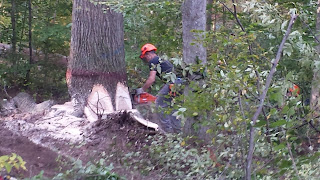Every now and then, I'll be at the lumberyard checking out their boards and think to myself - I wonder where this log grew up? It's hard to tell, especially if the logo of the company is painted on the side of the stack.
Here's an interesting log-to-lumber-mill story. I used to sell timber when I lived in Ohio. I owned 8 acres of mostly cherry trees, and during the 20 years of living on that land, I sold trees three different times. Sure, the money was nice, but it was more about responsibly thinning the forest, so the younger trees could flourish. These log-to-lumber stories are near to my heart.
My buddy Steve's family has a heavily wooded lot back in Ohio, and they sell timber about every 20 years from their land.
His dad had dealt with the lumber mill, Hillcrest Lumber, on a previous sale many years ago and was pleased with their performance.
Hillcrest is a small to medium sized mill, a family operation in NE Ohio's Amish country.
We're not talking small trees here!
The lumber mill subcontracted the logging to Nate Miller Logging, and the trees were felled by a 3 man crew for about 4 weeks, with a few breaks due to weather.
Timber buyers will often cold call a landowner, but you'll get better results by doing a little research. The Ohio Forestry Association is quite helpful with this.
This is some dangerous work!
Since Steve's family had a large volume of timber, the mill was willing to travel a relatively long distance from their mill in Apple Creek to get the logs. Short hauls to the mills are more common and can affect the market price the landowner receives.
The mill will process the logs into varying grades of green rough lumber. Steve wasn't sure if they had any veneer grade logs, but you can rest assured that those lumber buyers knew what they were buying. They're pretty sharp at grading the tree, just from checking out the bark and the limbs, even from a distance!
In all, they sold about 1300 trees from 140 acres, in a wide variety of species. Everything from the common major hardwoods, cherry, walnut, oak, maple, poplar, and ash to the less common beech, hickory, sycamore, elm, basswood, sassafras, and buckeye.
(I would have LOVED to get a few of those sassafras logs for some bowls!)
The timber graded out variously from prime to blocking. The largest trees exceeded 36 inches in diameter, the smallest were 18 inches or so.
Why sell trees, besides the obvious rea$on? First and foremost, a selective cut that thins the existing timber opens up the tree canopy and improves the growing conditions for younger trees.
And - they wanted to clear out the ash trees in anticipation of the arrival of emerald ash borers. If you ever get the chance to witness some logging going down, I highly recommend it.
The sound of the trees cracking as they fall is amazing. And the ground shakes like you wouldn't believe.... better than a thunderstorm!
Speaking of being out in the woods and seeing amazing things - these electricians found a baby deer out in the middle of nowhere.













1 comment:
Thank you Jamie for the first-hand account of the lumber process! My Great-Grandfather was a Lumber Grader in the early 1900's Minnesota and later in Copco, Oregon. I could always use the insight to flesh out my family's history.
Post a Comment